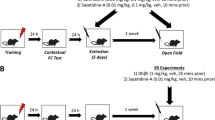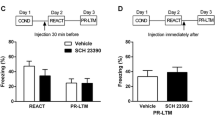Abstract
Rationale
Previous research indicates that nicotine administration enhances hippocampus-dependent forms of learning, including contextual fear conditioning. This effect is blocked by mecamylamine, a noncompetitive, broad-spectrum nicotinic receptor antagonist.
Objectives
The present study extends previous research by further characterizing the nicotinic acetylcholinergic receptor (nAChR) subtypes through which nicotine acts to enhance contextual fear conditioning.
Methods
C57BL/6J mice were trained with two conditioned stimulus (CS; 30 s, 85-dB white noise)–unconditioned stimulus (US; 2 s, 0.57-mA foot shock) pairings and tested 24 h later for contextual and cued fear conditioning. The effects of the α7 nAChR antagonist methyllycaconitine (MLA; 1.00, 10.00, and 20.00 mg/kg) and the effects of the α4β2 nAChR antagonist dihydro-beta-erythroidine (DHBE; 1.00, 3.00, and 6.00 mg/kg) on cued and contextual fear conditioning and on the enhancement of contextual fear conditioning by nicotine (0.25 mg/kg) were examined.
Results
We demonstrate that DHBE (all doses) administration attenuates the enhancing effect of nicotine on contextual fear conditioning, and MLA administration has no significant effect on the enhancement of contextual fear conditioning by nicotine.
Conclusions
The data suggest that non-α7 nAChRs (most likely α4β2 nAChRs) underlie the enhancement of contextual fear conditioning by nicotine.


Similar content being viewed by others
References
Alkondon M, Albuquerque EX (1993) Diversity of nicotinic acetylcholine receptors in rat hippocampal neurons. Pharmacological and functional evidence for distinct structural subtypes. J Pharmacol Exp Ther 265:1455–1473
Alkondon M, Pereira EFR, Almeida LEF, Randall WR, Albuquerque EX (2000) Nicotine at concentrations found in cigarette smokers activates and desensitizes nicotinic acetycholine receptors in CA1 interneurons of rat hippocampus. Neuropharmacology 39:2726–2739
Bancroft A, Levin ED (2000) Ventral hippocampal α4β2 nicotinic receptors and chronic nicotine effects on memory. Neuropharmacology 39:2770–2778
Bannerman DM, Grubb M, Deacon RM, Yee BK, Feldon J, Rawlins JN (2003) Ventral hippocampal lesions affect anxiety but not spatial learning. Behav Brain Res 139:197–213
Barros DM, Ramirez MR, Dos Reis EA, Izquierdo I (2004) Participation of hippocampal nicotinic receptors in acquisition, consolidation and retrieval of memory for one trial inhibitory avoidance in rats. Neuroscience 126:651–656
Berg DK, Conroy WG (2002) Nicotinic alpha 7 receptors: synaptic options and downstream signaling in neurons. J Neurobiol 53:512–523
Bettany JH, Levin ED (2001) Ventral hippocampus α7 nicotinic receptor blockade and chronic nicotine effects on memory performance in the radial-arm maze. Pharmacol Biochem Behav 70:467–474
Broide RS, Leslie FM (1999) The alpha7 nicotinic acetylcholine receptor in neuronal plasticity. Mol Neurobiol 20:1–16
Buisson B, Gopalakrishnan M, Bertrand D (1998) Stable expression of human neuronal nicotinic receptors. In: Arneric SP, Brioni JD (eds) Neuronal nicotinic receptors: pharmacology and therapeutic opportunities. Wiley-Liss, New York, NY, pp 99–123
Burwell RD, Saddoris MP, Bucci DJ, Wiig KA (2004) Corticohippocampal contributions to spatial and contextual learning. J Neurosci 24:3826–3836
Caldarone BJ, Duman CH, Picciotto MR (2000) Fear conditioning and latent inhibition in mice lacking the high affinity subclass of nicotinic acetylcholine receptors in the brain. Neuropharmacology 39:2779–2784
Cordero-Erausquin M, Marubio LM, Klink R, Changeux JP (2000) Nicotinic receptor function: new perspectives from knockout mice. Trends Pharmacol Sci 21:211–217
Curzon P, Brioni JD, Decker MW (1996) Effect of intraventricular injections of dihydro-beta-erythroidine (DHβE) on spatial memory in the rat. Brain Res 714:185–191
Decker MW, Brioni JD, Bannon AW, Arneric SP (1995) Diversity of neuronal nicotinic acetylcholine receptors: lessons from behavior and implications for CNS therapeutics. Life Sci 56:545–570
El Ghundi M, Fletcher PJ, Drago J, Sibley DR, O'Dowd BF, George SR (1999) Spatial learning deficit in dopamine D(1) receptor knockout mice. Eur J Pharmacol 383:95–106
Felix R, Levin ED (1997) Nicotinic antagonist administration into the ventral hippocampus and spatial working memory in rats. Neuroscience 81:1009–1077
Fenster CP, Rains MK, Noerager B, Quick MW, Lester RAJ (1997) Influence of subunit composition at low concentrations of nicotine. J Neurosci 17:5747–5759
Frazier CJ, Rollins YD, Breese CR, Leonard S, Freedman R, Dunwiddie TV (1998) Acetylcholine activates an alpha-bungarotoxin-sensitive nicotinic current in rat hippocampal interneurons, but not pyramidal cells. J Neurosci 15:1187–1195
Fujii S, Ji Z, Sumikawa K (2000) Inactivation of alpha7 ACh receptors and activation of non-alpha7 ACh receptors both contribute to long term potentiation induction in the hippocampal CA1 region. Neurosci Lett 286:134–138
Gommans J, Stolerman IP, Shoaib M (2000) Antagonism of the discriminative and aversive stimulus properties of nicotine in C57BL/6J mice. Neuropharmacology 39:2840–2847
Good M, Honey RC (1997) Dissociable effects of selective lesions to hippocampal subsystems on exploratory behavior, contextual learning, and spatial learning. Behav Neurosci 111:487–493
Gould TJ (2003) Nicotine produces a within subject enhancement of contextual fear conditioning in C57BL/6 mice independent of sex. Integr Physiol Behav Sci 38:124–132
Gould TJ, Higgins JS (2003) Nicotine enhances contextual fear conditioning in C57BL/6J mice at 1 and 7 days post-training. Neurobiol Learn Mem 80:147–157
Gould TJ, Lommock JA (2003) Nicotine enhances contextual fear conditioning and ameliorates ethanol-induced deficits in contextual fear conditioning. Behav Neurosci 117:1276–1282
Gould TJ, Wehner JM (1999) Nicotine enhancement of contextual fear conditioning. Behav Brain Res 102:31–39
Gould TJ, Collins AC, Wehner JM (2001) Nicotine enhances latent inhibition and ameliorates ethanol-induced deficits in latent inhibition. Nicotine Tob Res 3:17–24
Gould TJ, Feiro O, Moore D (2004) Nicotine enhances trace cued fear conditioning but not delay cued fear conditioning in C57BL/6 mice. Behav Brain Res 155:167–173
Graves L, Dalvi A, Lucki I, Blendy JA, Abel T (2002) Behavioral analysis of CREB alphadelta mutation on a B6/129 F1 hybrid background. Hippocampus 12:18–26
Grottick AJ, Higgins GA (2000) Effect of subtype selective nicotinic compounds on attention as assessed by the five-choice serial reaction time task. Behav Brain Res 3:27–38
Harvey SC, Maddox FN, Luetje CW (1996) Multiple determents of dihydro-β-erythroidine sensitivity on rat neuronal nicotinic receptor α subunits. J Neurochem 67:1953–1959
Jones S, Sudweeks S, Yakel JL (1999) Nicotinic receptors in the brain: correlating physiology with function. Trends Neurosci 22:555–561
Khiroug SS, Khiroug L, Yakel JL (2004) Rat nicotinic acetylcholine receptor α2β2 channels: comparison of functional properties with α4β2 channels in Xenopus oocytes. Neuroscience 124:817–822
Kim JJ, Rison RA, Fanselow MS (1993) Effects of amygdala, hippocampus, and periaqueductal gray lesions on short- and long-term contextual fear. Behav Neurosci 107:1093–1098
Klink R, de Kerchove d'Exaerde A, Zoli M, Changeux J (2001) Molecular and physiological diversity of nicotinic acetylcholine receptors in the midbrain dopaminergic nuclei. J Neurosci 21:1452–1463
Levin ED (2002) Nicotinic receptor subtypes and cognitive function. J Neurobiol 53:633–639
Levin ED, Torry D (1996) Acute and chronic nicotine effects on working memory in aged rats. Psychopharmacology 123:88–97
Levin ED, Simon BB (1998) Nicotinic acetylcholine involvement in cognitive function in animals. Psychopharmacology 138:217–230
Levin ED, Bradley A, Addy N, Sigurani N (2000) Hippocampal alpha 7 and alpha 4 beta 2 nicotinic receptors and working memory. Neuroscience 109:757–765
Logue SF, Paylor R, Wehner JM (1997) Hippocampal lesions cause learning deficits in inbred mice in the Morris water maze and conditioned-fear task. Behav Neurosci 111:104–113
Markou A, Paterson NE (2001) The nicotinic antagonist methyllycaconitine has differential effects on nicotine self-administration and nicotine withdrawal in the rat. Nicotine Tob Res 3:361–373
McGehee DS (1999) Molecular diversity of neuronal nicotinic acetylcholine receptors. Ann NY Acad Sci 868:565–577
Orr-Urtreger A, Goldner FM, Saeki M, Lorenzo I, Goldberg L, De Biasi M, Dani JA, Patrick JW, Beaudet AL (1997) Mice deficient in the alpha7 neuronal nicotinic acetylcholine receptor lack alpha-bungarotoxin binding sites and hippocampal fast nicotinic currents. J Neurosci 17:9165–9171
Owen EH, Logue SF, Rasmussen DL, Wehner JM (1997) Assessment of learning by the Morris water task and fear conditioning in inbred mouse strains and F1 hybrids: implications of genetic background for single gene mutations and quantitative trait analyses. Neuroscience 80:1087–1099
Papke RL, Sanberg PR, Shytle RD (2001) Analysis of mecamylamine stereoisomers on human nicotinic receptor subtypes. J Pharmacol Exp Ther 297:646–656
Paylor R, Nguyen M, Crawley JN, Patrick J, Beaudet A, Orr-Urtreger A (1998) α7 Nicotinic receptor subunits are not necessary for hippocampal-dependent learning or sensorimotor gating: a behavioral characterization of Acra7-deficient mice. Neurobiol Learn Mem 5:302–316
Perry DC, Xiao Y, Nguyen HN, Musachio JL, Davila-Garcia MI, Kellar KJ (2002) Measuring nicotinic receptors with characteristics of alpha4beta2, alpha3beta2 and alpha3beta4 subtypes in rat tissues by autoradiography. J Neurochem 82:468–481
Peters M, Mizuno K, Ris L, Angelo M, Godaux E, Giese KP (2003) Loss of ca2+/calmodulin kinase kinase beta affects the formation of some, but not all, types of hippocampus-dependent long-term memory. J Neurosci 23:9752–9760
Phillips RG, Ledoux JE (1992) Differential contribution of amygdala and hippocampus to cued and contextual fear conditioning. Behav Neurosci 106:274–285
Picciotto MR, Caldarone BJ, Brunzell DH, Zachariou V, Stevens TR, King SL (2001) Neuronal nicotinic acetylcholine receptor subunit knockout mice: physiological and behavioral phenotypes and possible clinical implications. Pharmacol Ther 92:89–108
Ramirez-Latorre J, Crabtree G, Turner J, Role L (1998) Molecular composition and biophysical characteristics of nicotinic receptors. In: Arneric SP, Brioni JD (eds) Neuronal nicotinic receptors: pharmacology and therapeutic opportunities. Wiley-Liss, New York, NY, pp 43–64
Rezvani AH, Levin ED (2001) Cognitive effects of nicotine. Biol Psychiatry 49:258–267
Roberts AJ, Krucker T, Levy CL, Slanina KA, Sutcliffe JG, Hedlund PB (2004) Mice lacking 5-HT receptors show specific impairments in contextual learning. Eur J Neurosci 19:1913–1922
Romanelli MN, Gualtieri F (2003) Cholinergic nicotinic receptors: competitive ligands, allosteric modulators, and their potential applications. Med Res Rev 23:393–426
Salminen O, Murphy KL, McIntosh M, Drago J, Marks MJ, Collins AC, Grady SR (2004) Subunit composition and pharmacology of two classes of striatal presynaptic nicotinic acetycholine receptors mediating dopamine release in mice. Mol Pharmacol 65:1526–1535
Stegelmeier BL, Hall JO, Gardner DR, Panter KE (2003) The toxicity and kinetics of larkspur alkaloid, methyllycaconitine, in mice. J Anim Sci 81:1237–1241
Stolerman IP, Naylor C, Elmer GI, Goldberg SR (1999) Discrimination and self-administration of nicotine by inbred strains of mice. Psychopharmacology 141:297–306
Tinsley MR, Quinn JJ, Fanselow MS (2004) The role of muscarinic and nicotinic cholinergic neurotransmission in aversive conditioning: comparing Pavlovian fear conditioning and inhibitory avoidance. Learn Memory 11:35–42
Turek JW, Kang C-H, Campbell JE, Arneric SP, Sullivan JP (1995) A sensitive technique for the detection of the α7 neuronal nicotinic acetylcholine receptor antagonist, methyllycaconitine, in rat plasma and brain. J Neurosci Methods 61:113–118
Van Dam D, D'Hooge R, Hauben E, Reyniers E, Gantois I, Bakker CE, Oostra BA, Kooy RF, De Deyn PP (2000) Spatial learning, contextual fear conditioning and conditioned emotional response in Fmr1 knockout mice. Behav Brain Res 117:127–136
Voikar V, Rossi J, Rauvala H, Airaksinen MS (2004) Impaired behavioural flexibility and memory in mice lacking GDNF family receptor alpha2. Eur J Neurosci 20:308–312
Wehner JM, Keller JJ, Keller AB, Picciotto MR, Paylor R, Booker TK, Beaudet A, Heinemann SF, Balogh SA (2004) Role of neuronal nicotinic receptors in the effects of nicotine and ethanol on contextual fear conditioning. Neuroscience 129:11–24
Williams M, Robinson JL (1984) Binding of the nicotinic cholinergic antagonist, dihydro-β-erythroidine, to rat brain tissue. J Neurosci 4:2906–2911
Wonnacott S (1997) Presynaptic nicotinic ACh receptors. Trends Neurosci 20:92–98
Woodruff-Pak DS (2003) Mecamylamine reversal by nicotine and by partial α7 nicotinic acetylcholine receptor agonist (GTS-21) in rabbits tested with delay eyeblink classical conditioning. Behav Brain Res 143:159–167
Wooltorton JR, Pidoplichko VI, Broide RS, Dani JA (2003) Differential desensitization and distribution of nicotinic acetylcholine receptor subtypes in midbrain dopamine areas. J Neurosci 23:3176–3185
Yu CR, Role LW (1998) Functional contribution of the α7 subunit to multiple subtypes of nicotinic receptors in embryonic chick sympathetic neurones. J Physiol 509:651–665
Zhang ZW, Coggan JS, Berg DK (1996) Synaptic currents generated by neuronal acetylcholine receptors sensitive to alpha-bungarotoxin. Neuron 17:1231–1240
Acknowledgements
The authors would like to acknowledge grant support from the American Federation for Aging Research (TG), the Pennsylvania Department of Health (TG), and Temple University (TG).
Author information
Authors and Affiliations
Corresponding author
Rights and permissions
About this article
Cite this article
Davis, J.A., Gould, T.J. The effects of DHBE and MLA on nicotine-induced enhancement of contextual fear conditioning in C57BL/6 mice. Psychopharmacology 184, 345–352 (2006). https://doi.org/10.1007/s00213-005-0047-y
Received:
Accepted:
Published:
Issue Date:
DOI: https://doi.org/10.1007/s00213-005-0047-y




